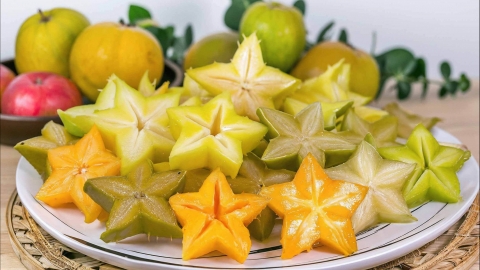What are the functions, benefits, and methods of consumption for carambola (starfruit)?
Carambola generally has functions and benefits such as clearing heat and detoxifying, promoting saliva production to relieve thirst, aiding digestion, enhancing immunity, and lowering blood lipids. Methods of consumption typically include eating fresh directly, drinking as juice, making salads, cooking sweet soup, and pickling as preserved fruits. Detailed explanations are as follows:

I. Functions and Benefits
1. Clearing Heat and Detoxifying: Carambola is cold in nature and possesses heat-clearing and detoxifying properties. It can help alleviate symptoms such as sore throat and mouth ulcers caused by excessive internal heat, making it suitable for moderate consumption during hot summer months or when experiencing internal heat.
2. Promoting Saliva Production and Relieving Thirst: Carambola contains abundant water and organic acids that can stimulate saliva secretion, relieve dry mouth and throat, and is especially suitable for replenishing bodily fluids after exercise or during hot weather, helping to restore the body's water and salt balance.
3. Aiding Digestion: Organic acids and dietary fiber in carambola can promote gastric juice secretion, accelerate food breakdown, and aid intestinal motility, improving digestive issues or food stagnation. However, it should not be consumed on an empty stomach.
4. Enhancing Immunity: Carambola is rich in vitamin C and other antioxidant substances, which can boost immune function, helping the body resist pathogen invasion. It is suitable for individuals with weak constitutions to consume moderately.
5. Lowering Blood Lipids: Carambola contains plant fiber and pectin, which can adsorb cholesterol in the blood, reduce fat absorption, and thus help lower blood lipid levels, offering certain benefits in preventing cardiovascular and cerebrovascular diseases.
II. Methods of Consumption
1. Eating Fresh Directly: After washing thoroughly, carambola can be sliced and eaten directly. Its crisp and tart flavor preserves the fruit's natural juiciness, making it a simple and healthy way to consume it.
2. Juicing: After removing the seeds, carambola can be juiced together with other fruits like apples or oranges, improving taste and increasing nutritional intake. It is suitable for consumption during breakfast or after exercise.
3. Making Salads: Sliced carambola can be mixed with vegetables such as cucumber and carrot, seasoned with olive oil and lemon juice, creating a refreshing salad ideal for summer consumption.
4. Cooking Sweet Soup: Carambola can be stewed with ingredients like red dates, wolfberries, and white fungus to make a delicious and nourishing sweet soup, suitable for women to regulate their health or for daily wellness purposes.
5. Pickling as Preserved Fruits: Sliced carambola can be pickled with sugar or honey and then air-dried to make preserved fruits. These are easy to store, have a unique flavor, and can be consumed as snacks.
However, carambola contains a neurotoxin that kidney disease patients cannot excrete, potentially leading to poisoning symptoms. Additionally, carambola has high oxalic acid content, and patients with stone-related diseases should avoid consuming it.







